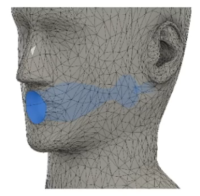Talk: Speech Source Directivity for Embodied Conversational Agents

Embodied conversational agents (ECAs) are computer-controlled characters who communicate with a human using natural language. Being represented as virtual humans, ECAs are often utilized in domains such as training, therapy, or guided tours while being embedded in an immersive virtual environment. Having plausible speech sound is thereby desirable to improve the overall plausibility of these virtual-reality-based simulations. In an audiovisual VR experiment, we investigated the impact of directional radiation for the produced speech on the perceived naturalism. Furthermore, we examined how directivity filters influence the perceived social presence of participants in interactions with an ECA. Therefor we varied the source directivity between 1) being omnidirectional, 2) featuring the average directionality of a human speaker, and 3) dynamically adapting to the currently produced phonemes. Our results indicate that directionality of speech is noticed and rated as more natural. However, no significant change of perceived naturalness could be found when adding dynamic, phoneme-dependent directivity. Furthermore, no significant differences on social presence were measurable between any of the three conditions.
Bibtex:
@misc{Ehret2021b,
author = {Ehret, Jonathan and Aspöck, Lukas and B\"{o}nsch, Andrea and Fels, Janina and Kuhlen, Torsten W.},
title = {Speech Source Directivity for Embodied Conversational Agents},
publisher = {IHTA, Institute for Hearing Technology and Acoustics},
year = {2021},
note = {Hybride Konferenz},
month = {Aug},
date = {2021-08-15},
organization = {47. Jahrestagung für Akustik, Wien (Austria), 15 Aug 2021 - 18 Aug 2021},
subtyp = {Video},
url = {https://vr.rwth-aachen.de/publication/02205/}
}

